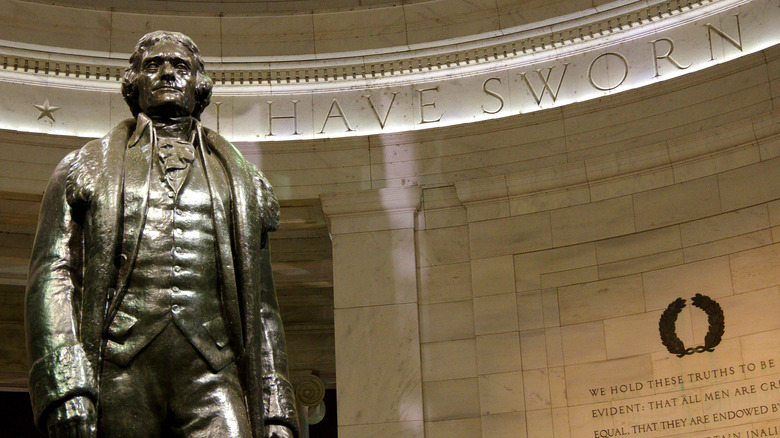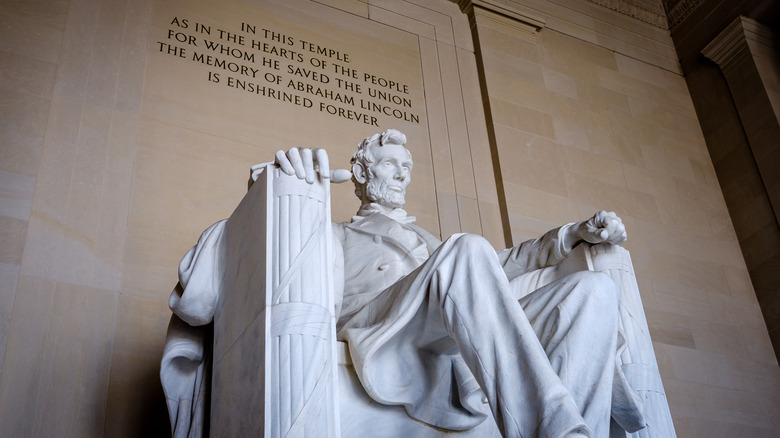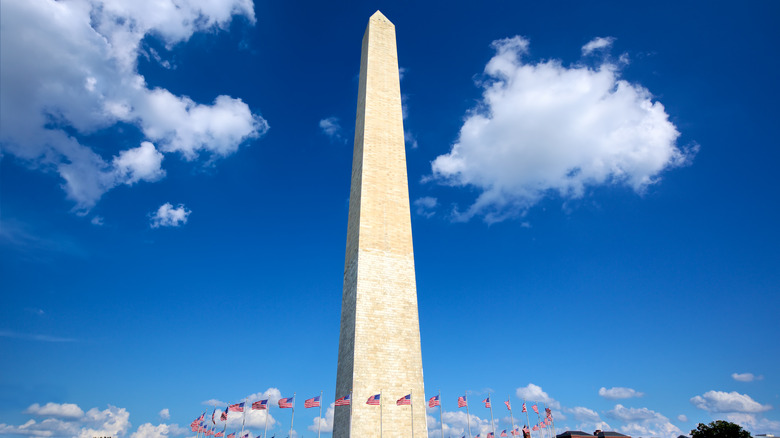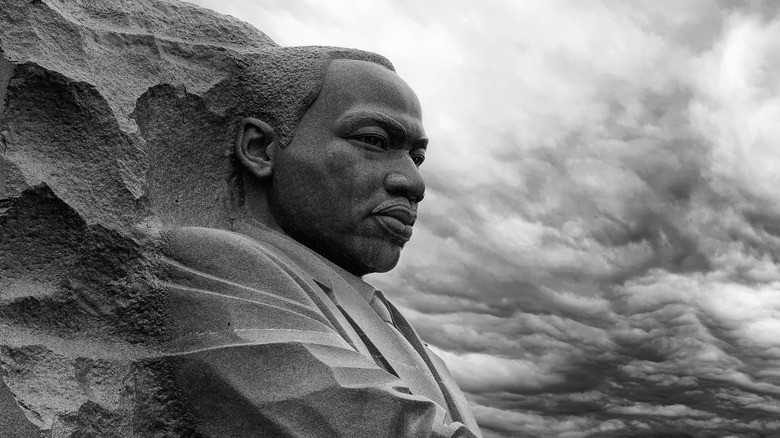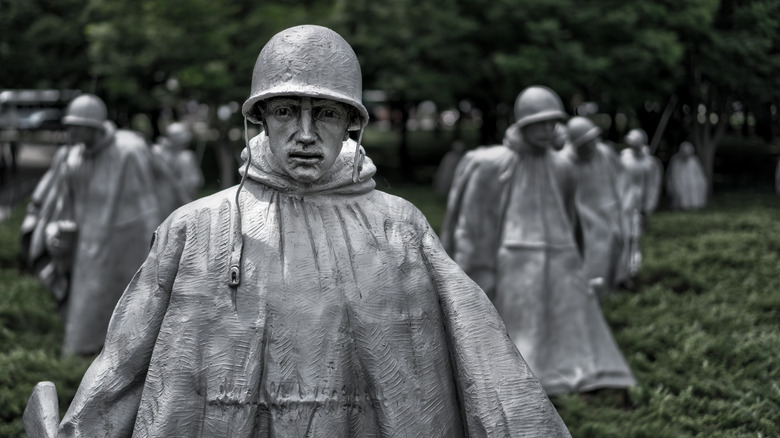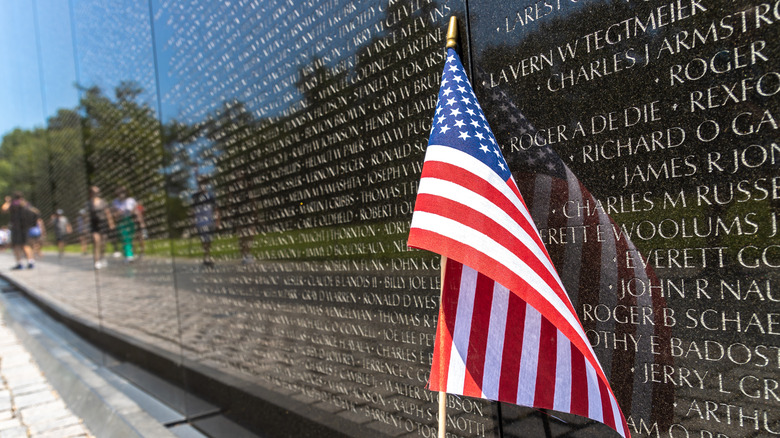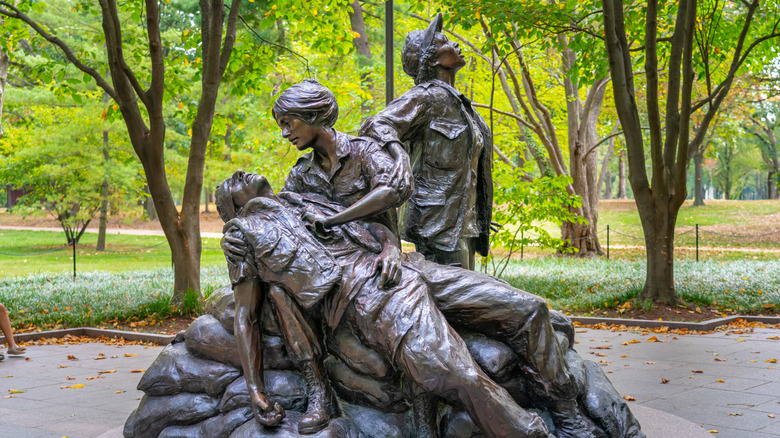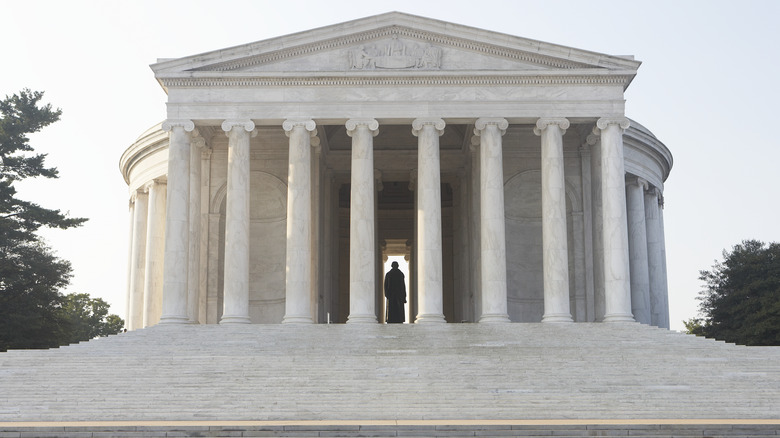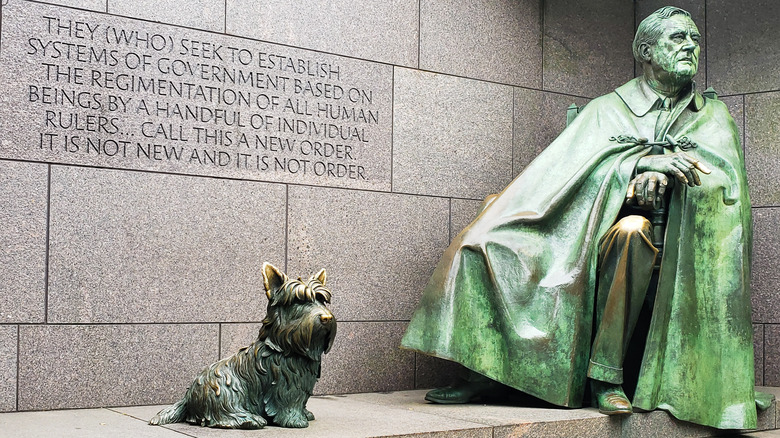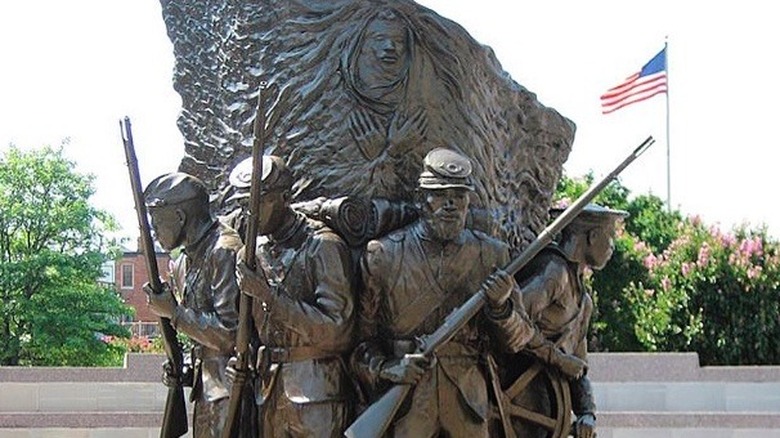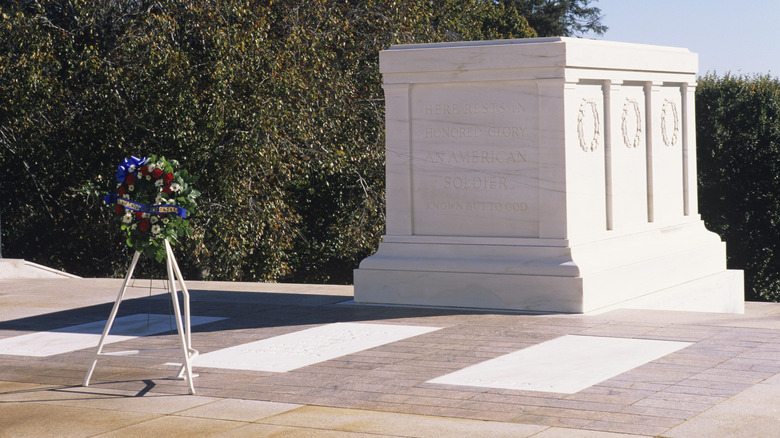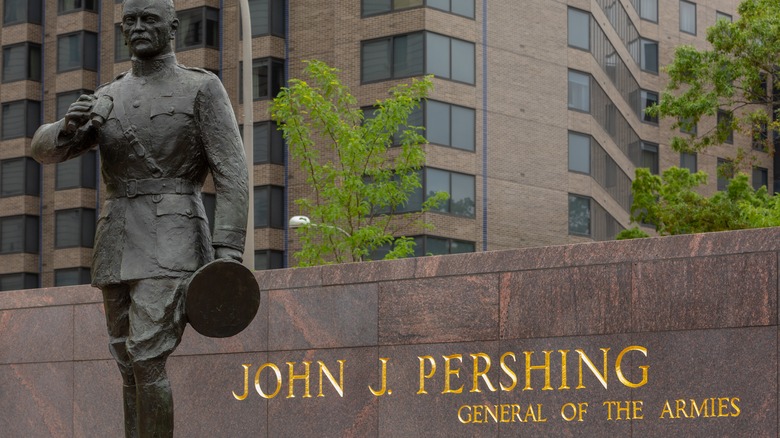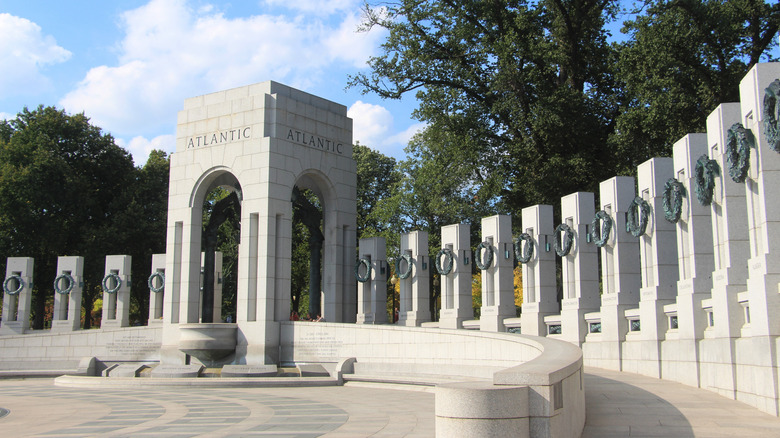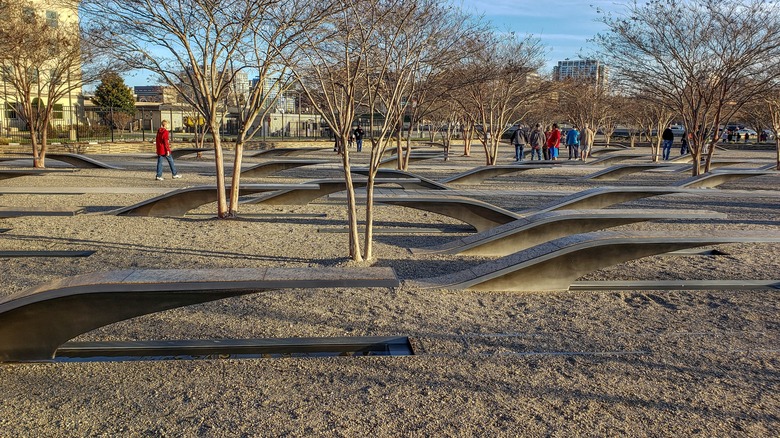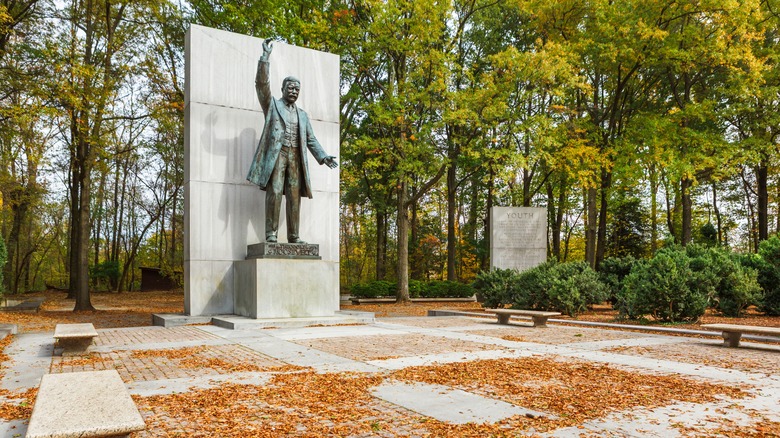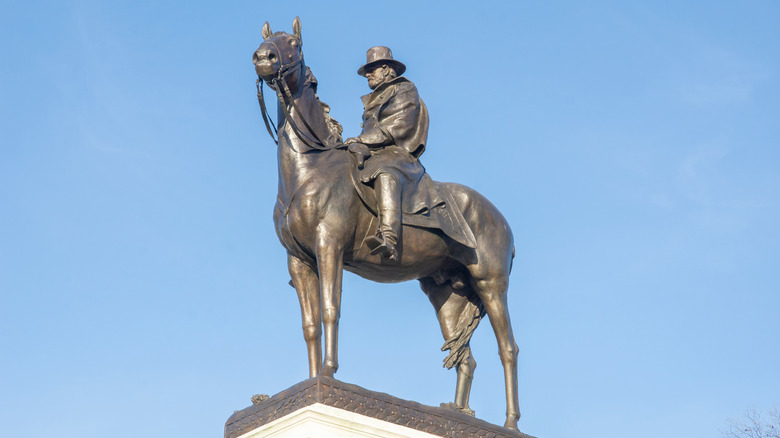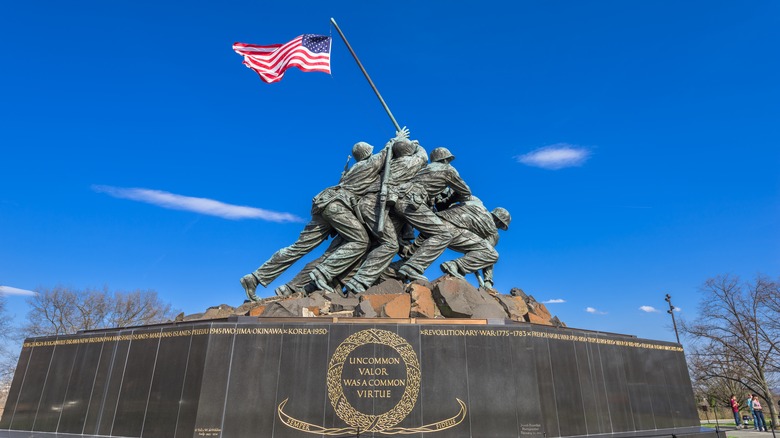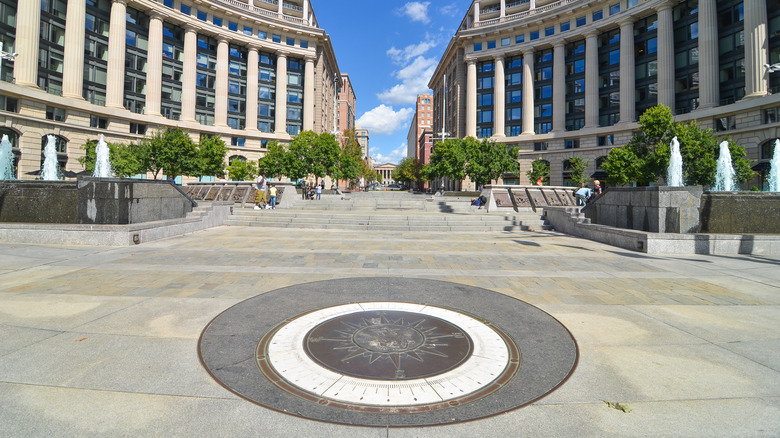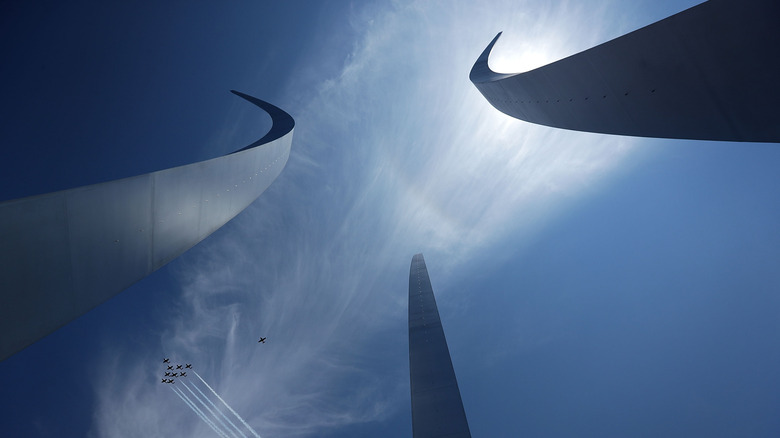The Ultimate Guide To Washington, DC's Best Memorials
Washington, D.C. is a city with a rich history behind it. As the American capital, every U.S. president from John Adams onward has led the country through times of crises and hardship from the national seat of government in the city. It's been an undeniably influential part of the U.S. government dating back to the earliest days of the republic, as closely tied to U.S. history as any one of the political figures who have stepped foot into the District of Columbia.
Given how intrinsically important Washington, D.C. is to the American political landscape, the city has a wide array of important historical sites to visit for anyone traveling to the capital. After all, the number of museums found within the city alone is virtually limitless, ranging from every one of the Smithsonian Museums to more niche attractions like those at the International Spy Museum. In addition to its remarkable array of museums, Washington is also well-known for its diverse assortment of memorials and monuments, each of which commemorates some of the country's veterans and most important political figures.
From monuments dedicated to America's most celebrated leaders to memorials honoring the military heroes who sacrificed their lives for their nation, here are some of Washington, D.C.'s best and most sobering memorial sites to visit.
The Lincoln Memorial
A landmark that instantly springs to mind when most people think of Washington, D.C., the Lincoln Memorial is also one of the largest memorials you'll find in the city. Housed in a massive neoclassical temple, visitors come face-to-face with the 16th president of the United States, Abraham Lincoln. Seated in the middle of the temple is a 19-foot marble statue of Abraham Lincoln, staring out at the wide expanse of Washington before him. Entering the temple, you'll find Lincoln's Gettysburg Address adorned on the wall to your left, with his second inaugural address on the wall to your right. This speech is considered among the most important written documents in American history, memorializing Lincoln's leadership skills during the U.S. Civil War.
Outside of the temple, you'll find a large reflecting pool that stretches nearly a mile toward the National World War II Memorial and Washington Monument. From here, you're able to walk toward several other monuments in the area, including the Vietnam Veterans Memorial, the Vietnam Women's Memorial, and the Korean War Veterans Memorial. Upon exiting the Memorial, if you head to the right, you'll also be able to walk towards the Tidal Basin, visiting monuments found there (the MLK, Jr. Memorial, the FDR Memorial, and the Jefferson Memorial).
When it comes to visiting these monuments, it's advisable to Uber, taxi, or Lyft to the Lincoln Memorial and make your way on foot around these sites. Alternatively, you can park your car at a free lot along Ohio Drive, SW.
The Washington Monument
Next to the Lincoln Memorial, there aren't many more monuments quite as iconic in the American landscape as the Washington Monument. A towering obelisk that ascends a whopping 555 feet straight up into the air, it's one of the oldest and most famous memorial sites in Washington, honoring the city's namesake — the first American president and Revolutionary War hero, George Washington.
Located almost a mile from the Lincoln Memorial, the Washington Monument stands on a hill overlooking most of Washington, D.C. For easy travel, it's recommended that you walk from the Lincoln Memorial, traveling either along the scenic Lincoln Memorial Reflecting Pool that bridges the two famed Washington landmarks or stopping by the Korean War Veterans Memorial or Vietnam Veterans Memorial along the way. Once there, be sure to actually walk up to the monument's base. Not only will you be afforded a great up close and personal look at the monument's foundation, but you'll also have some amazing views of several other notable Washington buildings. To the west, you'll have a stunning view of the Lincoln Memorial and the nearby National World War II Memorial; to the east, a straightforward look at the Capitol Building; and to the north, a decent view of the back of the White House. For an even more picturesque outlook, you can ride an elevator up to the top of the Monument, getting a panoramic view of Washington from a high-angle perspective.
The Martin Luther King, Jr. Memorial
A relatively new addition to the list of Washington's monuments, the Martin Luther King, Jr. Memorial was added to the city in 2011. Located in the West Potomac Park next to the Lincoln Memorial, the MLK, Jr. Memorial can be found along the Tidal Basin. Spread over four acres, the dominant figure in the center of the site is a sculpture of beloved civil rights activist, Martin Luther King, Jr.
Unlike most other statues of historical figures you'll find on this list, the sculpture of MLK, Jr. is a bit more artistic, with MLK, Jr. seen emerging out of a wall of granite. This distinct pose alludes to MLK's monumental "I Have a Dream" speech, fittingly delivered on the steps of the Lincoln Memorial close by, referencing King's words, "Out of the mountain of despair, a stone of hope." Said mountain can be found directly behind this statue. Surrounding the memorial site is an Inscription Wall complete with some of King's most moving quotes.
Given the MLK, Jr. Memorial's relatively close distance to the Lincoln Memorial (about a half mile away), it can be easily reached on foot or on a bike if you happen to be in West Potomac Park. It's also an ideal halfway point between the Lincoln Memorial and the more isolated Jefferson Memorial on the other side of the Tidal Basin. Once there, be sure to stop by the Franklin Delano Roosevelt Memorial, less than a quarter of a mile away.
The Korean War Veterans Memorial
Exiting the Lincoln Memorial down the path to your right, you'll find the Korean War Veterans Memorial, a harrowing place commemorating those who fought in the Korean War from 1950 to 1953. Originally constructed in 1995, this memorial has recently undergone a major expansion, with a large granite wall added in 2022 bearing the names of the American and South Korean personnel who perished in the conflict.
The Korean War Veterans Memorial has several different components. Entering the memorial's grounds, you'll instantly notice the memorial's defining characteristic: a series of 19 statues known collectively as "The Column." These statues – each of which stand at just over 7 feet tall – represent an American platoon on patrol, with each statue representing a branch of the U.S. military. Behind "The Column" is the Mural Wall, a 164-foot-long wall complete with images of Korean War veterans, taken from archival photographs of real soldiers in the war. To the left of the Mural Wall, you'll find the Pool of Remembrance, a shallow fountain 30 feet in diameter that lists the number of soldiers missing in action, killed in combat, or held as prisoners of war.
Given its convenient location in the West Potomac Park, walking or biking to the Korean War Veterans Memorial from the Lincoln Memorial or the Washington Monument is incredibly easy. Additionally, adding the memorial as a stop if you're near the Tidal Basin or the Lincoln Memorial will provide you with some scenic views of the park.
The Vietnam Veterans Memorial
From 1954 to 1975, the United States was embroiled in the Vietnam War, a widely unpopular conflict that was the longest war the U.S. has been involved in so far in the nation's history. To pay tribute to the scores of service members who lost their lives in this decade-spanning war is the Vietnam Veterans Memorial in West Potomac Park. Found halfway between the Lincoln Memorial and Washington Monument and nearly adjacent to the Korean War Veterans Memorial, the Vietnam Veterans Memorial is a harrowing landmark where you're able to honor the soldiers who fell in combat and receive a better understanding of the political controversies surrounding the war itself.
The Vietnam Veterans Memorial is spread over two acres of land, its chief component being a 246-foot-long granite wall with the names of the missing and deceased etched into its surface. Each section of the Memorial Wall is arranged as though it were an individual page in an opened book, with the engraved names organized by the date they fell in battle or went missing in action. Through this arrangement, the Memorial Wall tells the story of the Vietnam War from its start to its inevitable conclusion.
To reach the Vietnam Veterans Memorial, you can either walk or bike from the Lincoln Memorial, Washington Monument, or any other point of interest in West Potomac Park or along the National Mall. Once you're there, you also should make an effort to stop by the Vietnam Women's Memorial nearby.
The Vietnam Women's Memorial
Decidedly less well-known than the Vietnam Veterans Memorial is the neighboring Vietnam Women's Memorial, a historic landmark dedicated to the women who served in the Vietnam War. These women contributed to the war effort as doctors, nurses, air traffic control workers, and intelligence officers, aiding the American military in ways that are impossible to fully comprehend. It also underscores the danger these women faced on a regular basis, as well as their wholehearted willingness to put their lives on the line for the sake of helping their male counterparts in the field.
Located almost directly next to the Vietnam Veterans Memorial, the Vietnam Women's Memorial consists of a large statue showing three uniformed female military personnel comforting a male soldier wounded in combat. Due to its close proximity to the Vietnam Veterans Memorial, it can be easily reached by foot if you happen to be near the aforementioned monument. As one of the most sadly overlooked monuments you can find in Washington, D.C., it definitely deserves a visit. Once there, you'll also be able to stop by the Three Servicemen Statue, showing three American soldiers whose youthful ages are dramatically juxtaposed with the heavy weaponry they carried on their persons.
The Thomas Jefferson Memorial
Standing almost directly across the Tidal Basin from the Martin Luther King, Jr. Memorial is the Thomas Jefferson Memorial, preserving the memory of one of the nation's most influential Founding Fathers, the author of the Declaration of Independence, and the third U.S. president. Built in 1943, the Thomas Jefferson Memorial is one of the more visually impressive monuments you'll find near West Potomac Park. Like the Lincoln Memorial, the exterior temple housing the site is neoclassical in its design, reflecting Jefferson's own interests in architecture and the arts.
Inside the temple is a 19-foot bronze statue of Jefferson, as well as inscriptions engraved in the surrounding walls taken from Jefferson's words, including excerpts from the Declaration of Independence and letters Jefferson wrote to fellow Founding Fathers and U.S. presidents George Washington and James Madison during the earliest years of America's formation. In the memorial's lower levels is a small museum walking visitors through Jefferson's life, political career, and legacy in shaping the course of U.S. history.
Due to its location on the banks of the Tidal Basin, the Jefferson Memorial is without a doubt a picturesque spot to visit, especially when the cherry blossoms lining the shores are in full bloom. However, it's also a bit of a walk from the other points of interest in West Potomac Park, being roughly a mile away from the MLK, Jr. Memorial. With that in mind, you're better off either Ubering or biking from the Lincoln Memorial.
The Franklin Delano Roosevelt Memorial
Just over half a mile away from the Thomas Jefferson Memorial is the monument honoring the president who laid the cornerstone of the Jefferson Memorial in 1939: The Franklin Delano Roosevelt Memorial. Enshrined in the memory and lasting legacy of the 32nd president of the United States, the FDR Memorial is a fittingly distinct memorial with many different components to it.
Spread over 7.5 acres, the FDR Memorial features several walls bearing 22 of Roosevelt's most famous quotes, each of which reflects the tumultuous four terms he served as president, exemplified by the Great Depression and World War II. The memorial also incorporates several scenes depicting the Depression, with bronze sculptures partaking in common activities at the time, like standing in a breadline or listening to one of FDR's fireside chats. Naturally, the memorial also boasts a statue bearing FDR's likeness, with additional statues coming in the form of FDR's wife, Eleanor, and their beloved Scottish Terrier, Fala. As an added aside, the FDR Memorial is the only memorial in Washington to depict a presidential First Lady.
If you happen to be in West Potomac Park or near the Tidal Basin, reaching the FDR Memorial is incredibly easy. A four-minute walk from the MLK, Jr. Memorial and a 12-minute walk from the Jefferson Memorial, you're able to walk or bike to the memorial or have your Uber/taxi drop you off along West Basin Drive, SW.
The African American Civil War Memorial
One of the few memorials in Washington, D.C. to have an entire museum dedicated to it is the African American Civil War Memorial Museum in Northwest Washington, about three miles north of the National Mall. As the name suggests, this memorial pays homage to the 209,000 Black soldiers who fought for the Union during the U.S. Civil War. Additionally, the memorial is dedicated to the memory of the seven thousand white officers, two thousand Hispanic soldiers, and 20,000 sailors who served in the unsegregated U.S. Navy at the time.
Outside of the African American Civil War Memorial Museum is a 9-foot bronze statue titled "The Spirit of Freedom." This statue depicts three Black infantry soldiers and one Black sailor, flanked by an unfurled American flag. On the other side of the flag are the faces of the soldiers' family members, bidding the troops goodbye as they depart for the war. Surrounding "The Spirit of Freedom" is a large wall featuring the names of the 209,145 soldiers who fought in the war, listed according to their specific regiment.
As parking for the memorial is based on available parking spaces on the street, it's recommended that you either bike or arrange a taxi/Uber to get to the memorial instead. In addition to seeing the memorial, it's also certainly worth visiting the adjoining museum across the street, which teaches visitors about how instrumental Black volunteers were in turning the tide of the Civil War in the Union's favor.
The Tomb of the Unknown Soldier
Visiting the Arlington National Cemetery should be at the top of every Washington, D.C. visitor's to-do list. Not only is it an incredibly peaceful resting place for the thousands of U.S. soldiers, their families, and dignitaries across American history buried there, but it's also a place where you can pay respect to the scores of service members who risked their lives for the sake of the nation. This is especially the case for the Tomb of the Unknown Soldier, one of the famed memorial sites.
The Tomb of the Unknown Soldier is dedicated to the deceased U.S. service members whose remains were unable to be identified. The Tomb was officially founded in 1921, serving as the gravesite for an unidentified soldier who fell on the battlefields of World War I. Since then, the Tomb of the Unknown Soldier has remained a widely-visited memorial within Washington, D.C., with the members of the U.S. Army guarding the Tomb on a 24/7 basis. Visitors to Arlington can witness the changing of the guards at the Tomb every hour and half hour (depending on the season), as well as wreath-laying ceremonies paying tribute to the veterans who lost their lives in service of the country.
While you're at Arlington Cemetery, you should also try to visit the Tomb of the Civil War Unknowns Monument outside Arlington House, a gravesite commemorating the 2,111 Civil War soldiers buried there whose remains are largely unidentified.
The National World War I Memorial
It's not altogether very common for a memorial to receive its own park, the National World War I Memorial being a notable exception. Located in Pershing Park along Pennsylvania Avenue (directly across the street from the White House Visitor Center), the National World War I Memorial commemorates the 4.7 million American soldiers who fought in the First World War.
The National World War I Memorial is interesting for a few different reasons. A fantastic memorial site today, it also promises to be an exceptional dedication to veterans of the Great War in the future, with a notable extension planned to arrive in 2024. This extension consists of a large mural sculpture titled "A Soldier's Journey" paying homage to the American troops who served in the war. Currently, you'll also find a statue at the memorial site depicting John J. Pershing, the park's namesake and leader of the American Expeditionary Forces on the Western Front. Nearby is a fairly large fountain (known as the Peace Fountain), adorned with a poem by Archibald MacLeish and several quotes from battles the American Army participated in during the conflict.
To reach Pershing Park, it's best to either walk or bike your way from the National Mall, as the park is within easy walking distance of the White House. While the "A Soldier's Journey" sculpture is set to open next year, a large poster featuring a preliminary sketch of the piece currently hangs in the park.
The National World War II Memorial
Sitting directly beneath the Washington Monument and at the opposite end of the Lincoln Memorial Reflecting Pool is the National World War II Memorial. As with its fellow entries on this list, the National World War II Memorial is one of the most notable memorial sites in West Potomac Park, as well as one of the most visually striking.
The memorial features a massive fountain known as the Rainbow Pool, as well as 56 surrounding pillars, each of which represents America's individual states and territories. On either side of the fountain are two large arches inscribed with "Atlantic" and "Pacific" respectively, referencing the two main theaters of combat Americans fought in during World War II. Both arches also list the respective battles Americans participated in each theater of the war. In an impressive nod to historical accuracy, the memorial even includes two hidden "Kilroy was here" engravings, a reference to a cartoon drawing American troops would leave behind in Allied territory to signify their presence.
As with the other memorials in West Potomac Park, it's easier navigating to the National World War II Memorial on foot than it is driving to the site. Alternatively, you can have an Uber or taxi drop you off between the memorial and Washington Monument, as 17th Street Southwest bisects the two sites. Doing so, however, deprives you of the gorgeous walk along the Lincoln Memorial Reflecting Pool, forcing you to backtrack if you want to see the Tidal Basin.
The United States Holocaust Memorial Museum
As with the African American Civil War Memorial Museum, the United States Holocaust Memorial Museum acts as the country's official memorial to the victims of the Holocaust. An unbelievably heartbreaking place to visit – as well as one of Washington, D.C.'s finest museums – the United States Holocaust Memorial Museum truly encapsulates the anguish and horror all those unfortunate enough to be persecuted in the Holocaust faced on a regular basis. It tells the stories of all those who perished, escaped, or endured the horrendous conditions of the ghettos and concentration camps they were imprisoned within, as well as their narratives rebuilding their lives anew after the fact.
Described by the museum's founders as a "living" museum, the Holocaust Memorial Museum is a place everyone should visit when they come to Washington, D.C. Not only does it contain first-hand testimony from survivors and provide in-depth information about the Holocaust, it also emphasizes awareness about genocide, anti-Semitism, and Holocaust denial, promoting basic human rights for all.
To tour the U.S. Holocaust Memorial Museum, it's important to keep in mind that the museum does not have any free parking lots open for visitors. A paid parking garage can be found nearby in-between 13th and 14th Streets on D Street, SW, with street parking available on Independence Avenue. If you're near West Potomac Park, you can also walk or bike to the museum, as the memorial is only about a 7 minute walk (or 0.3 miles) from the Washington Monument.
The National 9/11 Pentagon Memorial
September 11 is a day that will forever live in infamy in the annals of world history. On that notorious day, several hijacked planes tragically crashed into New York City's Twin Towers and the Pentagon in Washington, D.C., killing or injuring thousands of innocent people. Commemorating the lives lost at these unprecedented attacks are the National September 11 Memorial & Museum in New York and the National 9/11 Pentagon Memorial in Washington, D.C., both of which are located at the approximate sites of the September 11 attacks.
The National 9/11 Pentagon Memorial serves as a permanent outdoor monument preserving the memories of the 184 people who lost their lives during the attack. To represent each victim of the assault on the Pentagon,184 special aluminum benches are evenly arranged around the site, with every bench engraved with a victim's name and organized according to their respective ages. The benches' placement also depends on whether the victim worked in the Pentagon or was traveling aboard American Airlines Flight 77 at the time of its crash; to reflect this, the victims who were in the Pentagon during the attack have their benches facing the building, with those on Flight 77 turned southward (the direction the plane came from).
Parking at the National 9/11 Pentagon Memorial is highly limited. To visit the site, you can either arrange for an Uber or taxi to take you, or travel along the Metrorail to the Pentagon or Pentagon City, walking to the memorial from the station.
The Theodore Roosevelt Island National Memorial
It's not often you see a park dedicated to a historical personage in Washington, D.C., never mind an entire national park. Existing as an exception to this rule is the Theodore Roosevelt Island National Memorial, perhaps the largest memorial in Washington, D.C. Covering a 90-acre island in the Potomac River, Roosevelt Island preserves the memory of the 26th U.S. president, Theodore Roosevelt. Going hand in hand with Roosevelt's lifelong advocacy for environmental conservation, Roosevelt Island is an expansive national park where visitors are encouraged to explore and partake in numerous outdoor activities.
Entering the park, you'll encounter a 17-foot-tall statue of Roosevelt, one arm raised as though bidding visitors welcome to his gorgeous island refuge. Nearby are two large fountains and four stone sculptures bearing some of Roosevelt's most famous quotes.
Once used as the training grounds for Union troops during the Civil War, Roosevelt Island is today known for its surprisingly diverse landscapes. Despite its relatively small size, the island features environments ranging from lush temperate forests to swamplands, marshes, and bedrock fields. During your visit to the island, you'll have the opportunity to partake in either a self-guided or guided hike led by a National Park Ranger, look out for rare birds that frequent the area, or kayak or canoe off the island's shores. The island can be reached by parking your car in a designated lot in Virginia, making your way across a small footbridge to the park.
The Ulysses S. Grant Memorial
An underrated monument in the American capital has to be the Ulysses S. Grant Memorial on Capitol Hill. Positioned in front of the Capitol Building, the memorial is chiefly known for its large statue of Grant on horseback, the Civil War hero and 18th American president overlooking the Capitol Reflecting Pool below. Interestingly, this figure is the biggest equestrian statue in the U.S., and the fourth largest in the world. Along the statue's base are bronze murals showing squadrons of Union infantry as a nod to Grant's stint as Commanding General of the U.S. Army.
If you visit the Capitol Building at all on your trip, stopping by the Ulysses S. Grant Memorial is an absolute must. Not only is the statue incredibly detail-oriented and awe-inspiring in its size, its position along the Reflecting Pool makes it an extremely scenic monument as well. In the area surrounding the Capitol Reflecting Pool, you'll also see several other statues, including four bronze lions near the base of Grant's statue, and two sculptures titled "Cavalry Charge" and "Artillery." The former shows a mounted Union cavalry charging forward; the latter a Union artillery crew hauling a cannon via horse-drawn buggy.
Because of its high volume of visitors, parking near the Capitol Building can be a bit of an issue, with free lots nearby nowhere to be found. To get around this, it's advisable to Uber, taxi, or Lyft your way to the Capitol, and then walking to the memorial and Reflecting Pool.
The United States Marine Corps War Memorial
There are several amazing monuments to visit within Arlington National Cemetery, including the eternal flame marking the grave of former President John F. Kennedy and a memorial commemorating the members of the Space Shuttle Challenger. Along with those important memorials is the U.S. Marine Corps War Memorial, located just outside the cemetery in Arlington Ridge Park.
As its name suggests, the U.S. Marine Corps War Memorial is dedicated to every Marine whose lives were lost in service to the U.S. dating back to the start of the Revolutionary War. The centerpiece of the memorial is the massive bronze statue in the middle of the park, featuring six Marines working together to raise a 60-foot American flag in the air. The memorial statue is taken almost directly from the iconic image of Marines raising the flag on Mount Suribachi following the 1945 World War II victory at Iwo Jima. The statue is enshrined with the list of every major war that the Marines took part in since America's foundation in 1776, from the Revolutionary War up to the War on Terror.
Unlike most other monuments on this list, the U.S. Marine Corps War Memorial has a parking lot that you're able to leave your vehicle at. The memorial site is also known to have Sunset Parades – organized and led by the U.S. Marine Corps – every Tuesday at 7 pm throughout the summer. These performances last approximately one hour, and run from June into the first of August.
The United States Navy Memorial
Within the boundaries of Washington, D.C., you'll find memorials for every branch of the U.S. military, with the United States Navy Memorial being located just off Pennsylvania Avenue. Amid business buildings, restaurants, and apartment complexes, the United States Navy Memorial can be found in its own succinct plaza. Commemorating those who served in the Navy, Marine Corps, Coast Guard, and the Merchant Marine, it's a large memorial site that does plenty of justice to those it was established to honor.
Once you step inside the Navy Memorial's Visitors Center, you'll browse through an interactive museum that houses numerous exhibits, ranging from informative films to over 740,000 testimonies of Navy personnel from years past. Exiting the Visitors Center, you'll be able to take in some breathtaking views of the neighboring National Archives Museum, and a granite map of the world that doubles as a stage for concerts and special live events throughout the year. Here, you'll also be able to see the famed Lone Sailor statue, a bronze sculpture depicting a uniformed Navy seaman. Placed around the Sailor are large pillars representing a ship's masts, and fountains containing water from each of the seven seas.
Parking for the U.S. Navy Memorial can be found at the PMI Garage on 875 D Street, NW. If you're anywhere near the National Mall, you can also walk or bike to the memorial instead. If you'd like to take the Metrorail, a stop is provided at the Archives/Navy Memorial along the train's route.
The United States Air Force Memorial
As with the U.S. Marines Corps and the U.S. Navy, the U.S. Air Force similarly has a memorial site dedicated to its military branch in Washington as well. This monument can be found just outside Arlington National Cemetery roughly one mile away from the National 9/11 Pentagon Memorial. The United States Air Force Memorial honors all members who joined the service and its preceding branches prior to the Air Force's official formation in 1947.
One of the most unique and largest memorial sites in Washington, the United State Air Force Memorial is chiefly comprised of three stainless steel sculptures extending upwards of 400 feet in the air. The distinct fluid shape of these sculptures is meant to reflect the aerial patterns of modern fighter jets, specifically through their rapid "bomb burst" precision maneuver. On the ground, you'll find granite plaques acknowledging the contributions of specific Air Force pilots, and inscriptions detailing everything from balloon reconnaissance to test flights dating back to the earliest days of the airplane.
The United States Air Force Memorial does offer free parking admission to all visitors, although the lot itself is limited to only 28 spaces. To avoid any issues that come with a full lot, you should either schedule an Uber, Lyft, or taxi to drop you off as close as possible to the site instead. Or, like the National 9/11 Pentagon Memorial, you can take the Metrorail to the Pentagon or Pentagon City, and walk to the monument from there.
